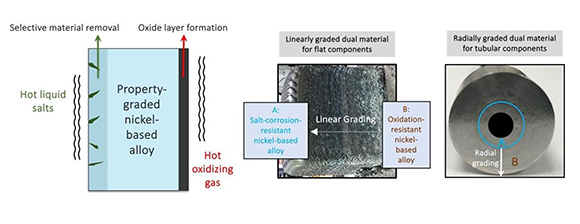ORNL’s research using Additive Manufacturing for high-temperature alloys wins Best Paper award
April 22, 2024

Rishi Pillai and his research team from the US Department of Energy’s (DOE) Oak Ridge National Laboratory (ORNL) in Tennessee, USA, will receive a Best Paper award from the American Society of Mechanical Engineers International Gas Turbine Institute in June at the Turbo Expo 2024 in London, UK.
The winning paper, titled “Leveraging Additive Manufacturing to Fabricate High Temperature Alloys with Co-Designed Mechanical Properties and Environmental Resistance,” was originally presented by Pillai at the Turbo Expo 2023 in Boston, Massachusetts, USA.
The ORNL scientists co-designed a compositionally graded nickel-based alloy for molten halide salts-supercritical carbon dioxide heat exchangers with the objective of mitigating the environmental degradation of surfaces exposed to molten halide salts on one side and the oxidising atmosphere on the heat exchangers’ opposing surface while preventing the consequent thermal and corrosion-induced deterioration in mechanical stability.
This work demonstrated the applicability of Additive Manufacturing to design and fabricate materials that possess both strength and corrosion resistance to perform in extreme environments, such as nuclear reactors or power generation systems.
“Conventional materials design protocols strive to achieve individual physical properties by following a sequential approach, but they fail to anticipate the consequences of complex interactions between underlying phenomena,” Pillai shared. “For example, events such as environmental degradation and thermomechanical stability can substantially impact efficiency, performance and life cycle requirements.”
Although the prevailing solution of applying oxidation-resistant and thermal-barrier coatings to protect metal alloy parts from harsh conditions has made today’s energy and flight technologies possible, limitations persist with respect to the parts’ long-term performance.
“Typically, coating inside surfaces is very difficult because you don’t have line of sight, and in really small parts such as tubes and narrow channels, the drop in pressure makes controlling chemical vapor deposition processes to apply uniform and adherent coatings extremely challenging and virtually impossible,” Pillai added. “Our research opens up a new area for developing alloys with co-optimised properties. The advantages are that you are grading the chemistry of the material as you fabricate it, allowing the manufacturing of the whole component while completely eliminating the need for joining processes — for example, brazing in heat exchangers — in the part you are making.”
Over time, chemically incompatible systems in the coatings can begin to interact in ways that degrade the properties of the coatings and the supporting surfaces. The ORNL researchers demonstrated that an Additive Manufacturing technique can overcome those challenges by gradually varying the makeup of the material as it is deposited throughout the additively manufactured object.
“Carefully chosen compositional grading determined with the help of high-fidelity material degradation models and component lifetime assessment considers that a part will be in service for 30,000 to 50,000 hours at temperatures relevant to the application of interest,” stated Pillai. “We can choose a grading that minimises the interaction between the different required chemistries of the part’s materials while providing the required resistance to the environmental degradation on the surface. The outcome is that we fabricate a high-temperature alloy material with co-optimised mechanical properties and corrosion resistance and eliminate the need for coatings.”
The research applied three pillars: computationally assisted material development, manufacturing parameter optimisation and advanced characterisation. The team used computational tools to examine how to create the alloy with certain performance and environmental degradation resistance properties. They also used parameter optimisation to ensure crack-free fabrication of the various geometric shapes needed for parts, such as heat exchanger plates and tubes, along with advanced characterisation, to carefully inspect the microstructure of the fabricated parts.
Preliminary corrosion and mechanical testing of the graded product from the study demonstrated its potential to replace the coated materials.
Pillai commented, “The Turbo Expo committee and the audience acknowledged that even though I chose an alloy intended for molten halide salts-supercritical carbon dioxide heat exchangers, they could see the value of transposing the approach to gas turbines and other applications.”
The work was performed under a Laboratory Directed Research and Development (LDRD) programme, the Digital Metallurgy Initiative project, led by Pillai. In contrast to the serial method, co-design addresses the mechanical and corrosion stability aspects of the architectures in parallel. This approach is said to create precisely tailored zone-based material properties that are critical to the successful realisation of next-generation energy technologies.
Download Metal AM magazine

















